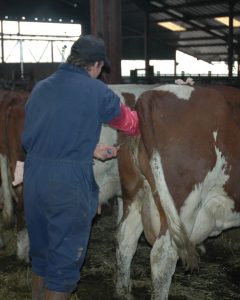Problems with Vegetarianism

A vegetarian diet excludes all animal flesh. This is often done for moral, religious, or health reasons. Vegetarianism is considered a step closer towards our optimal diet, leading to better health, and ethical treatment of innocent animals.
In general, vegetarians enjoy a lower risk of cardiovascular disease, obesity, type 2 diabetes, and many cancers. (1) On the other hand, the vegetarian diet is also known to cause human disease, while supporting animal abuse as a result of consuming eggs, honey and dairy products.
Vegetarianism originated in ancient India, and is often associated with religions such as Hinduism and Buddhism. Over the past few decades, the practice of vegetarianism has become more popular in the United States. Unfortunately, many of those who practice vegetarianism seem to be unaware, or unwilling, to accept the damage that vegetarian diet cause to their health, animals, and the environment.
When it comes to health, a vegetarian diet can be as damaging, if not worse, than an omnivorous diet. The reason being that those who become vegetarians tend to substitute their flesh intake with large quantities of dairy, which is now being recognized as one of the worst food sources available. Milk doesn’t only wreak havoc on most people’s digestive system, it also separates loving mothers from their precious babies, leading to world spread suffering, deforestation and global pollution of land, water and air.
We could make dozens of arguments against dairy products and spend a whole chapter (or a whole book) on the subject. Instead, let us simply list a handful of points to consider:
#1 – Humans are the only specie that drink another specie’s milk. Humans are also the only animals that drink milk beyond their infancy stage. The only reason why humans drink milk is because they can. It has been shown that our bodies don’t need it at all.
#2 – About 75 percent of the world’s population lose their lactase enzymes after weaning. (2) This simply means that 75% of the world’s population can’t properly digest milk. This condition is known as lactose intolerance.
#3 – Calcium from animal milk is not absorbed as well as that from plant-based sources and it may lead to dangerous health problems. (3)
#4 – Those who consume large quantities of dairy are more likely to sustain fractures than those who drink little to no milk. (4) The reason being that dairy milk is an acidic substance that takes calcium away from the bones to help alkalinize the body’s pH levels.
#5 – Evidence suggests that the consumption of milk and other dairy products leads to an increased risk of prostate cancer. In addition, dairy-free diets have shown to slow the progress of prostate cancer. (5)
#6 – Many studies show that the consumption of all types of cow’s milk may be linked to an increased prevalence and severity of acne in children. (6)
#7 – Milk is extremely high in cholesterol which is known to cause plaque buildup on the circulatory system. This may eventually lead to heart disease and stroke. Milk is also high on saturated fat which may lead to cardiovascular problems as well as obesity.
Derivatives of milk such as cheese and yogurt can be worse due to their processing methods. On top of all that, milk products require to capture, enslave, torture and rape innocent animals by using some of the most inhumane methods in the animal farming industry.
The production and consumption of dairy products is also known to cause massive damage to the environment in multiple ways and massive proportions. To learn more about this topic we recommend you watch a popular speech on YouTube titled “The Best Speech You Will Ever Hear by Gary Yourofsky”. (7) Another excellent source on this topic is a documentary called “Cowspiracy”.
Previews Section:
Problems with Omnivorism
Next Section:
Problems with the Vegan Diet
Thank you for reading!
Please donate to help us publish this book.
PayPal: trevesbruno@gmail.com
Venmo: @Bruno-Treves
Sources:
(1) https://academic.oup.com/ajcn/article-abstract/89/5/1627S/4596952?redirectedFrom=fulltext
(2) https://pdfs.semanticscholar.org/4d36/ff28161df5bdfd24989069cc06e68dfe325f.pdf
(3) http://ajcn.nutrition.org/content/89/5/1638S.full
(4) http://www.bmj.com/content/349/bmj.g6015
(5) http://www.goldjournal.net/article/S0090-4295(00)00974-2/abstract
(6) http://onlinelibrary.wiley.com/doi/10.1111/j.1365-4632.2009.04002.x/full
